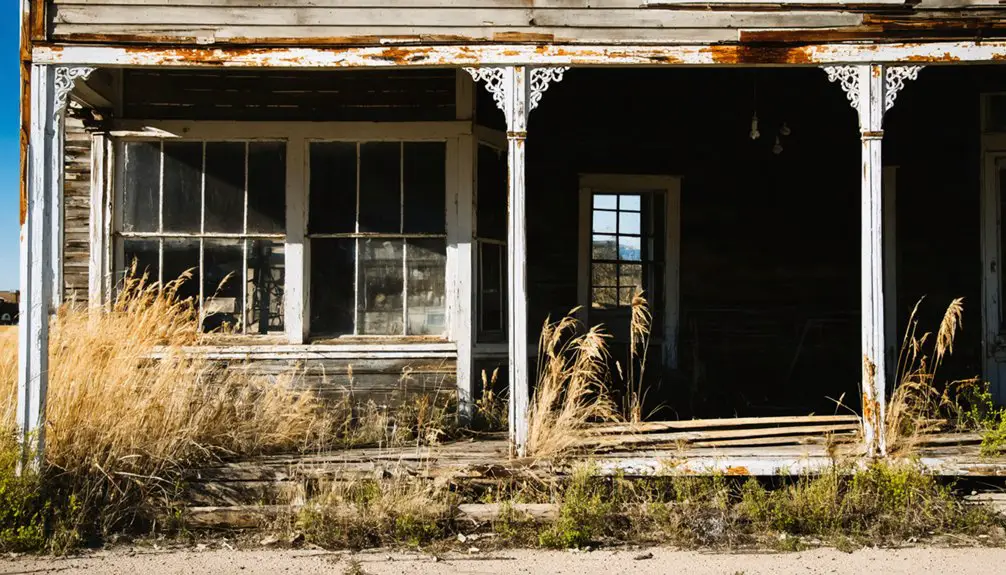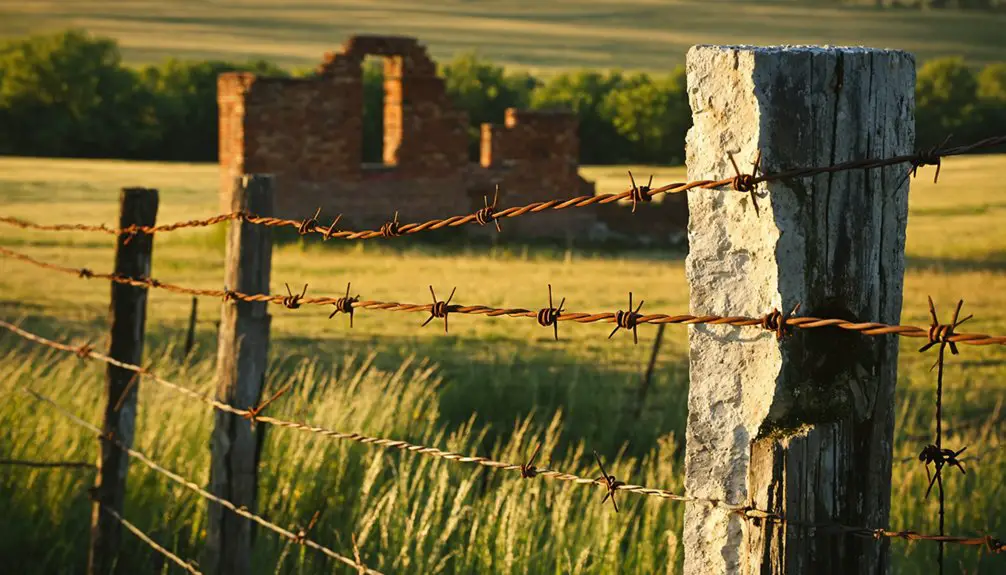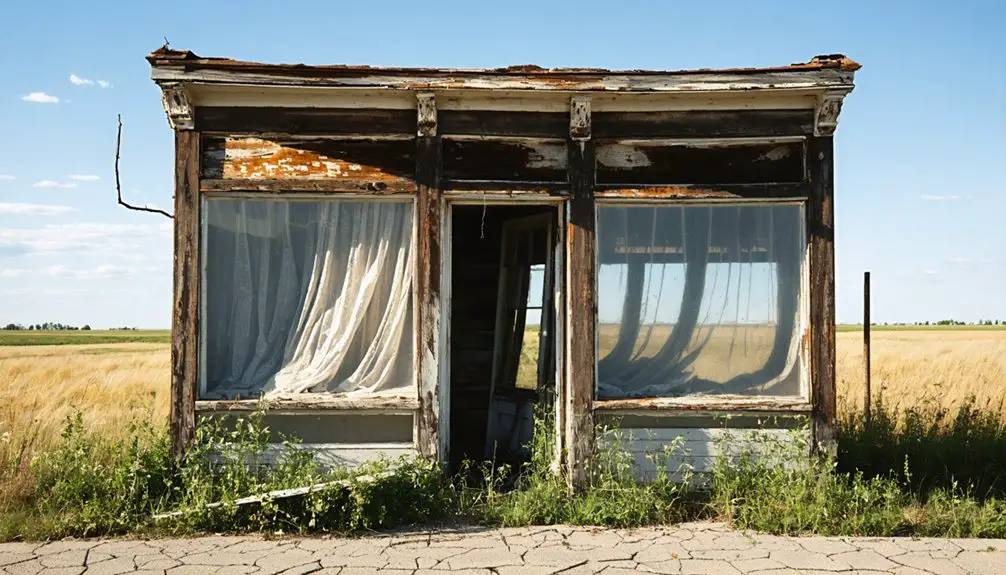You’ll find Geary City’s ghost town ruins along the Missouri River, where it once stood as a crucial free-state stronghold during “Bleeding Kansas” in the 1850s. Named after territorial governor John W. Geary, the settlement flourished with bustling shops, a flour mill, and railroad connections until 1905. Though prairie fires and time have claimed most original markers, its role in Kansas’s anti-slavery movement and territorial conflicts shaped the state’s future in fascinating ways.
Key Takeaways
- Geary City was established in the 1850s as a free-state settlement during “Bleeding Kansas,” named after territorial governor John W. Geary.
- The town flourished as a commercial center from 1857-1905, featuring businesses like Rigby’s flour mill and essential services for local settlers.
- Kansas Pacific Railroad’s arrival in 1866 transformed Geary City into a transportation hub between Kansas City and Denver.
- The removal of railroad tracks and closure of the post office in 1905 led to rapid population decline.
- The town disappeared completely by 1905, with only prairie fires and time erasing physical markers of its existence.
The Birth of a Free-State Stronghold
During the tumultuous period known as “Bleeding Kansas” in the mid-1850s, Geary City emerged as an essential free-state stronghold along the Missouri border. The settlement’s free state origins were deeply rooted in its steadfast opposition to pro-slavery forces, and you’ll find its namesake in territorial governor John W. Geary, who worked to bring peace to the region. Ongoing attacks from local raiders led to the formation of armed militia patrols to defend against violent incursions.
Free-State settlers faced brutal attacks from Southern militia camps that regularly plundered their properties and threatened their safety. As a critical defensive outpost, the town’s anti-slavery resistance proved instrumental in protecting free-state interests.
You’ll discover that Geary City’s strategic position and determined inhabitants played a pivotal role in transforming the nearby town of Atchison into free-state territory. The settlement’s unwavering stance against Missouri’s border ruffians helped establish it as a beacon of liberty in northeastern Kansas.
Life Along Commercial Street
If you’d walked down Commercial Street in Geary City’s heyday, you’d have encountered a bustling thoroughfare where Rigby’s famous flour mill, Dr. Grube’s medical practice, and George D. Johnson’s blacksmith shop served the community’s daily needs.
The street’s stone and brick buildings housed not just businesses but also acted as social hubs where residents gathered to exchange news and conduct their affairs. Much like San Francisco’s Geary Boulevard that started as a dirt carriage track, Commercial Street began as a humble pathway that grew into prominence.
You’d have witnessed six-yoke teams hauling flour to regional markets while locals visited the nearby lawyer James McCahon or conducted business with Sheriff Porter, reflecting the street’s role as both a commercial and civic center.
Much like Junction City’s first brick building constructed in 1861, the structures along Commercial Street represented the town’s early architectural progress.
Daily Business Operations
Life along Commercial Street in Geary City bustled with a diverse mix of professional services and trade activities that defined the town’s economic core.
You’d find Dr. Franklin Grube’s medical practice, renowned for his international experience, alongside James McCahon’s law office and George D. Johnson’s crucial blacksmith shop. Business hours and trade practices followed typical frontier patterns, with merchants adapting to local needs. Like many businesses of the era, some merchants operated shops with living quarters above, similar to the arrangement at Glick’s Grocery in nearby Junction City. The abundant magnesian limestone resources in the area provided building materials for many of the street’s structures.
The street’s crowning achievement was Jonothan A. Rigby’s flour mill, which, though operating only a year, gained fame across Missouri and Kansas.
Six yoke of oxen transported goods along the thoroughfare, while nearby stagecoach lines and mail routes kept the town connected.
Professional services expanded as the population grew, with Sheriff Robert J. Porter and others contributing to the street’s reputation as a significant commercial hub.
Social Gathering Places
Along Commercial Street’s vibrant corridor, social gatherings naturally centered around essential businesses that doubled as community hubs.
You’d find residents congregating at Johnson’s blacksmith shop, where the ring of hammer on anvil marked a popular spot for exchanging news and views.
Dr. Grube’s practice served as another social venue, where patients shared stories while awaiting treatment.
The flour mill, under Rigby’s management, became a focal point for community gatherings, drawing farmers and traders from surrounding areas. Like San Francisco’s early Muni streetcars, these gathering spots contributed significantly to the area’s reconstruction and development.
McCahon’s law office attracted civic-minded citizens discussing local politics, while Sheriff Porter’s presence helped maintain order during social events.
These establishments created an interconnected network of social venues that kept Geary City’s community spirit alive through commerce and conversation.
Architecture and Layout
While social gatherings defined the spirit of Geary City, Commercial Street’s physical design shaped how residents experienced daily life. Similar to how ghost tourism brings life to historic buildings today, these structures once bustled with activity.
You’d have found a classic ghost town architecture of wood-frame buildings with false fronts lining the carefully planned commercial street layout, designed to connect seamlessly with the Bob-Tail Road and railroad tracks. Like the old brick schoolhouse that still stands outside Dighton, these buildings serve as silent witnesses to a bygone era.
Walking down Commercial Street in its heyday, you would’ve encountered:
- Covered wooden boardwalks protecting you from the elements while connecting the town’s businesses
- General stores with large display windows, like Collis B. Roundy’s establishment, anchoring the commercial district
- Simple yet practical buildings serving dual purposes as shops below and residences above
The town’s grid pattern, with roads intersecting Commercial Street at right angles, made navigation straightforward for both locals and visitors.
Political Tensions and Border Conflicts
During the turbulent period known as Bleeding Kansas, Governor John Geary‘s arrival in September 1856 marked a pivotal attempt to quell the violent territorial conflicts.
You’ll find that political divisions ran deep, with Geary deploying over 1,000 federal troops to counter both proslavery forces and Free-State militias. His conflict resolution strategy included dispersing nearly 3,000 Missourian “Border Ruffians” who threatened Lawrence, a Free-State stronghold.
Despite claiming neutrality, Geary’s friendships with Free-State leaders Charles Robinson and Samuel Pomeroy created suspicion among proslavery factions. His rejection of aid from Vermont deepened tensions between opposing sides.
His authority was further undermined when the Pierce administration withdrew support for continued troop deployment.
The region’s instability continued as violent raids, electoral fraud, and murders persisted between Missouri Border Ruffians and Kansas Free-State defenders, ultimately bleeding into the Civil War.
Daily Life in Early Geary City

Life in early Geary City centered around simple wooden frame houses and log cabins that dotted the frontier landscape. Your home would’ve served multiple purposes – living, cooking, and sleeping all in one or two rooms. You’d tend to your family gardens and manage communal livestock to sustain your household.
Your daily routines would’ve included:
- Working the land through farming, ranching, or operating local sawmills
- Participating in community gatherings at the one-room schoolhouse or church
- Trading at general stores and blacksmith shops along the central dirt road
When you weren’t working, you’d join your neighbors for social events that strengthened community bonds.
Despite harsh weather and isolation, you’d find comfort in the shared determination of frontier life, where education and progress remained essential priorities.
The Railroad Era and Economic Peak
When the Kansas Pacific Railroad reached Geary County in 1866, you’d have witnessed Geary City transform into a bustling transportation hub with multiple rail lines connecting east-west and north-south routes.
You’d have seen the rapid development of essential railroad infrastructure, including depots, roundhouses, and workshops, which attracted settlers and created jobs for maintenance and operations personnel.
Your business ventures would have thrived during this economic peak, as the railroad enabled farmers to ship their crops and cattle to broader markets while stimulating the growth of stockyards, grain elevators, and supportive commercial enterprises.
Railroad Brings Economic Growth
As the Kansas Pacific Railroad completed its tracks to Junction City in November 1866, the region experienced a transformative economic surge.
You’d witness railroad expansion bringing unprecedented growth through essential infrastructure investments, including a $20,000 bridge across the Smoky Hill River and establishment of significant railway facilities.
The economic transformation created three major impacts:
- A rapid influx of immigrants claimed available land, driving population growth
- Agricultural commerce flourished with new stockyards, grain elevators, and depots supporting wider market access
- Railway operations generated employment through roundhouses and workshops, diversifying the local economy
Junction City emerged as a strategic rail hub, hosting multiple railway lines and the U.S. land office.
The Railroad Addition of 1870 expanded the town’s footprint, accommodating the growing industrial and residential needs tied to rail activity.
Peak Trading Years 1857-1905
The arrival of the railroad marked only part of Geary City’s notable trading era, which had begun years earlier in 1857.
You’d have found a bustling center of community commerce, where local businesses served the agricultural needs of settlers and farmers throughout the region. The town’s strategic position allowed it to supply goods and services to nearby Fort Riley, while the influx of Free-State settlers drove increased demand for crucial supplies.
During these peak years, Geary City’s economic strength rested on its agricultural significance, with farming and livestock activities providing steady income for townspeople.
Small stores thrived by offering essential supplies to the growing agricultural community. This period of prosperity lasted until 1905, when the removal of railroad tracks and westward migration began to unravel the town’s economic fabric.
Transportation Hub Develops Networks
By establishing itself along the Kansas Pacific Railroad‘s expanding line in 1866, Geary City positioned itself within an essential transportation network that would reshape Kansas’s economic landscape.
You’ll find that railroad expansion transformed the region’s connectivity, replacing earlier stagecoach routes along the Smoky Hill Trail with faster, more reliable transportation innovations.
The development brought three key changes to the area:
- New infrastructure emerged, including bridges, roundhouses, and workshops that created jobs.
- Trade routes opened between Kansas City and Denver, making Geary City a critical stop.
- Mail service improved dramatically, with tri-weekly coaches connecting to Santa Fe.
This transportation revolution sparked rapid immigration and land acquisition, as settlers seized opportunities in newly accessible territories along the expanding rail network.
Notable Families and Early Settlers
Military personnel stationed at Fort Riley formed the backbone of Geary County’s earliest settlement, with soldiers and officers establishing the region’s first communities after the fort’s creation in 1852.
You’ll find that founding families like Colonel William Montgomery helped organize Pawnee on the military reservation, while officers Robert Wilson and Abram Barry incorporated Junction City around 1855.
Among early landowners, Thomas Reynolds settled near Ogden, representing the civilian presence amid military dominance.
The Cincinnati-Manhattan Company, through land agents including John Pipher, attempted to establish Manhattan in the area.
While some settlement attempts like Millard existed mainly on paper due to inactive eastern speculators, the remaining settlers ultimately contributed to Junction City’s emergence as the region’s primary community.
The Decline Years: 1900-1905

While early settlers had established a promising free-state community, Geary City faced stark decline between 1900 and 1905.
You’ll find this period marked the town’s transformation from a hopeful settlement into a ghost town, driven by severe economic stagnation and population decline.
Three critical events sealed Geary City’s fate:
- The removal of railroad tracks in 1905, cutting off essential transportation links
- Closure of the post office, which had operated since 1857
- Mass exodus of residents seeking opportunities in more prosperous regions
You can trace the town’s rapid deterioration through these changes, as families abandoned their homes and businesses shuttered.
Neighboring Ghost Towns and Settlements
Throughout Geary County and its surrounding regions, several ghost towns shared similar fates with Geary City during the mid-to-late 1800s.
You’ll find Pawnee’s dramatic story, where its brief five-day reign as territorial capital ended in forced demolition by federal troops in 1855.
Kansas Falls emerged as a lumber town in 1857 but couldn’t survive after the Kansas Pacific Railroad bypassed it in 1867.
The ghost town origins often centered around early trading posts, mills, and speculative ventures, with neighboring settlements like Millard failing due to fraudulent land sales.
Early frontier settlements rose and fell around trading outposts and mills, their fates sealed by shady land deals and speculation.
Transportation played a decisive role in these towns’ destinies – just as the incomplete Palermo Railroad doomed Geary City, the railroad’s route choices determined whether communities would thrive or fade into history.
Archaeological Remnants and Land Markers

Based on archaeological surveys and detailed 1882 plat maps, you can still trace the ghostly footprint of Geary City today through its scattered physical remnants.
Archaeological techniques reveal the town’s layout through foundation stones, while artifact analysis has uncovered period-specific items that paint a picture of daily life in this frontier settlement.
You’ll find these key remnants across the site:
- Building foundations and scattered 19th-century artifacts including nails, glass shards, and ceramic fragments
- Historic wagon road remnants that once connected important landmarks and burial sites
- Mill equipment ruins near Kansas Falls that highlight the area’s industrial heritage
The Missouri River’s natural features, including riverbanks and wooded ravines, continue to shape the landscape where this once-promising settlement stood, though prairie fires and time have claimed many original markers.
Historical Impact on Kansas Territory
As tensions escalated during the “Bleeding Kansas” period, Geary City emerged as a crucial Free-State stronghold that helped shape Kansas Territory’s political landscape.
You’ll find its significance reflected in how it bolstered Atchison’s anti-slavery position and resisted Missouri’s border ruffians, ultimately influencing Kansas’s trajectory toward becoming a free state.
During Governor John W. Geary‘s territorial governance in 1856-57, the city played a strategic role while he attempted to restore order amid the chaos.
Though Geary’s neutrality stance proved controversial, the city’s resistance efforts contributed to preventing pro-slavery control of the territory.
While Geary City’s population later declined and the town eventually disappeared by 1905, its impact on Kansas Territory’s development remained influential enough that Geary County still bears the governor’s name today.
Frequently Asked Questions
What Types of Businesses and Industries Operated in Geary City Before 1905?
You’d find a bustling flour mill, blacksmith shop, doctor’s office, and law practice thriving alongside agricultural development, though railroad expansion ultimately bypassed these pioneering enterprises.
Were There Any Notable Crimes or Lawlessness Incidents in Geary City?
You won’t find much documented crime history or law enforcement activity in the records, as most surviving information focuses on the town’s Free-State movement role against pro-slavery forces.
What Happened to the Town’s Buildings After Its Abandonment?
You’ll find those abandoned structures slowly faded into the landscape – most deteriorated naturally while a few were reclaimed by descendants interested in historical preservation. Only foundations and overgrown roadways remain today.
Did Any Native American Tribes Have Settlements Near Geary City?
You’d find evidence of Kansa (Kaw), Osage, and Wichita tribal settlements near what became Geary City, with archaeological findings like burial mounds and artifacts confirming Native American presence in the area.
What Was the Highest Recorded Population of Geary City?
While historical records show rapid population growth during the 1850s-1860s, you won’t find Geary City’s exact peak population documented. Its historical significance faded before formal census counts could capture specific numbers.
References
- http://gearyhistory.blogspot.com/2014/10/kansas-falls-ghost-town-and-one-room.html
- https://en.wikipedia.org/wiki/Geary
- https://lostkansas.ccrsdigitalprojects.com/sites/lostkansas/files/private_static/2022-12/LT_DP_GearyCity_Laroff.pdf
- https://en.wikipedia.org/wiki/Pawnee
- https://core.ac.uk/download/pdf/33368282.pdf
- https://resources.ohiohistory.org/ohj/search/display.php?page=39&ipp=20&searchterm=Array&vol=34&pages=292-421
- https://www.latinamericanstudies.org/book/Geary_and_Kansas.pdf
- https://legendsofkansas.com/johnson-county-border-troubles/
- https://jeffersonjayhawkers.com/tag/geary-city-era/
- https://legendsofkansas.com/junction-city-kansas/



